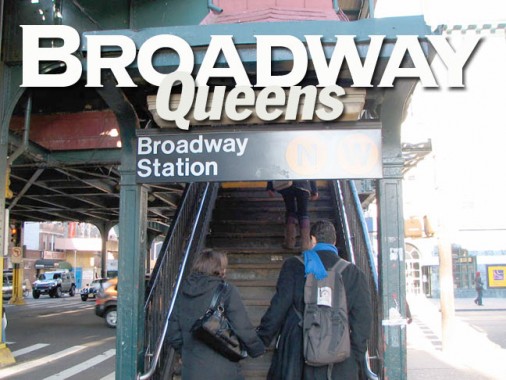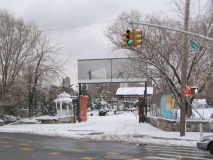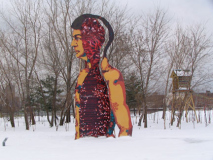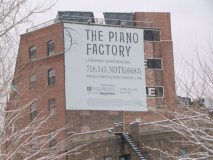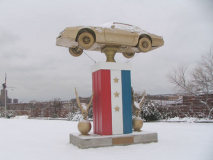Continuing my fascination with NYC’s non-Manhattan Broadways, which begain in June 1999 with my very first ForgottenTour on Brooklyn’s Broadway, continued on several Forgotten NY pages there, and then continued further on the Bronx’ Broadway in late 2008, I hiked Queens’ very own Broadway in December 2008 and Jaunary 2009. The route begins in Ravenswood at the East River edge, and plunges southeast into the heart of Elmhurst, indeed the center of the original town of Newtown (Middleburgh) first settled by Dutch colonials in 1652 (after an original settlement 10 years earlier in Maspeth had foundered after Indian attacks). Queens’ Broadway, which attained its present length only in the early 20th Century, is an amalgam of a number of roads: Broadway in Ravenswood ran southeast to the now-demapped Ridge Road near Newtown Road; and the southern part between Woodside Avenue and Queens Boulevard is the eastern section of the colonial-era Hellgate Ferry Road, which conected Elmhurst and the East River; twisting Woodside Avenue follows most of its route today.
I must admit that I’m unsure when these two roads were joined to create the present-day Queens Broadway. Maps from the 1910s and 1920s show a completed Broadway, but that may be a figment of mapmakers’ imaginations (they often show maps the way city agencies say the street will eventually appear). Meanwhile, historian Vincent Seyfried (the unsung master chronicler of Queens whose work inspires every borough and city historian) maintains, in Old Queens, NY in Early Photographs, that Broadway was only connected with Long Island City and Elmhurst when the IND subway was opened in 1933. In any event, we can call Queens’ Broadway the youngest of all the boroughs’ Broadways.
Socratic
Broadway begins at Vernon Boulevard at 11th Street (known as simply “Boulevard” in the pre-street numbering days) and here we find the entrance to Socrates Sculpture Park, which surprisingly was not completely deserted on a 15-degree day following a snowstorm.
Named in tribute to its proximity to Greek-flavored Astoria, this waterside area along Vernon Boulevard between 31st Avenue and Broadway was a dumpsite until it was “rescued” in 1986 by a coalition of artists/activists headed by Mark di Suvero. It now works both as an outdoor workshop for aspiring artists and as a waterside park.
Exhibits change frequently, but on a 2001 visit I walked around a wall filled by what looked like Delft pottery tiles screened with images of Colonel Sanders and Chairman Mao; the pediment from the top of one of the old brick buildings in the neighborhood detached and placed on the ground, and a large group of human-sized plaid doughnuts. Lots of fun!
In the two photos on the bottom you can see the old Sohmer piano factory. In recent years owned by the Adirondack Chair Company, the buildings had been endangered by encroaching development; but if you can’t beat ’em, join ’em and in the boroughs, at least, the only way to save a venerable structure is to convert it to luxury housing. Here in Ravenswood, just south of Astoria along the East River, the skyline is dominated by the massive Con Ed “Big Allis” power plant and Ravenswood Houses, but a walk though its narrow streets reveals surprising remnants of old-time Queens. A Steinway competitor, Sohmer Piano, constructed this factory in 1887, a multilevel factory building complete with clock tower. Its original copper roof was replaced with tin and then painted green some years ago. The old factory still has its ancient Hewes and Phillips coal burner. The building, now officially landmarked, has had its clock restored “to the second” according to developer Angelo Acquista of the TTW Realty Group. [astorians]
It’s not the only piano factory converted to luxury in NYC of late — I was taken by surprise to discover that the fortress-like, hulking Steinway factory on Ditmars Boulevard and 45th Street in Astoria became the Pistilli Grand Manor, and the clock-towered Estey Piano building and its distinctive clock tower in the Bronx’ Mott Haven became residential in the early 2000s.
Sohmer pianos? They are now manufactured in Korea.
Luxury is hardly in evidence as we begin eastward on Broadway, noting an abandoned garage and some broken wooden seats at the Q104 bus stop (the bus runs along Broadway to the 46th/Bliss Street stop on the #7 train). Broadway runs past an athletic field and warehouses here.
At 14th Street (old Hopkins Avenue) we find a Super 8 motel and a lot of frosted tires, making them look like huge frosted chocolate Dunkin Donuts, or, perhaps, donut Oreos. I knew Super 8 from film used on countless grainy family videos in the Super 70s, but didn’t know it was a motel chain too. It’s apparently two steps up from Motel 6, the Tom Bodett “leave a light on for you” place.
I was fascinated by this apparently abandoned house at 14-35 Broadway — the windows were covered by cello and the steps were unshoveled — but you never know. I was stalking around Woodside a couple of weeks ago and snapped a building at 50th Avenue and 66th that looked all but deserted, only to be hailed by the old gaffer who owned it, shuffling up the street. I told him I wouldn’t use the photos. “Oh, no problem,” he said, “unless you’re with the Queens Forum.”
The stylized front of 14-55 Broadway, with its helmeted warrior stencil, was the first inkling of Hellenicity I found.
21st Street (Van Alst Avenue) is the main truckers’ throughfare running in a straight line from the Astoria subneigborhood of Ditmars SW to the Queens Midtown Tunnel entrance in Hunters’ Point. It is a surprisingly yawn-inducing run, but at Broadway we find the excellent chrome-plated Bel Aire Diner, named NYC’s best diner by the Daily News in 2005. It has been a part of the landscape since 1965.
As we pass 21st Street, Broadway becomes more and more residential/commercial, a trend that will crescendo near the 31st Street el. Here a venerable 2-story building with a hideous 1st floor makeover complete with fake stonework and fresh graffiti sidles up to a modern abomination, while nearby the classy Norman Arms still holds forth. In LIC and Astoria, building names often reflect former street names (hence the Carver Arms and Singer Apartments) but that’s not the case here. Nearby is the Strand, which in Manhattan is synonymous with used books, but here, is full of televisions.
It was looking a lot like Christmas in this holiday scene at Broadway and 30th Street (formerly 1st Avenue) in December 2008. I don’t know why LIC began its original street numbering so far from the East River, and since the street was renumbered about 80 years ago, I suppose that’s a question that will never be answered. In the background we see a C-Town supermarket and one of Astoria’s tall apartment buildings dating to the mid to late 1920s. I have got to get that aluminum tree and color wheel for next year. I had them all through my childhood.
Let me now praise this Deco-era stepped-facade building. It used to be a theatre or a bowling alley, and perhaps housed both during it career.
Question: does the average layman know what MSRP stands for? I do, as I write and edit ads for a direct mail company, but does everyone?
1/21: This was the Strand Theatre, remembered in the Strand Electronics name shown above. The building on the extreme right was the bowling alley. The theatre opned in 1941, surviving into the 1980s.
Cinematreasures lists hundreds of theatres around the country called The Strand. Why that name? A strand is a loose, thin piece of material, does it have another meaning?
The 31st Street, or Astoria, el opened for business on July 19, 1917. The World War I era was a halcyon time for Queens els — the Flushing el also was opened out to 103rd street in Corona that year, following by two years the Fulton Street el’s extension out to Lefferts Avenue (now Boulevard). When the el was opened, 31st Street was called 2nd Avenue.
I always check the light posts under an el, and 31st Street presents a rather unusual set of Dwarves. They lack the usual four fluted bolt caps on the base that other NYC posts have, indicating a different manufacturer. And, this one has a diffuser-less luminaire, another NYC anomaly.
I’d imagine this building on the north side of Broadway and 31st Street, visible from the platform, was home to doctors’ offices at one time, with the intertwined snakes on the staffs.
LEFT: I got this shot purely by accident (that’s how a lot of good photos happen). I was shooting the sign and didn’t see the couple ascending the steps. RIGHT: stencil cigar store sign. This type of letttering is very common in NYC although beginning to peter out. On my Roosevelt Avenue signs page, Forgotten Fan Don Brunjes explained that the Coca-Cola Company provided the signs:
The [yellow] tin letters on [green] background were offered to shopkeepers by local Coca-Cola bottling companies. The letters were attached the [green] portion of the sign to spell out whatever the vendor wanted and are referred to as the “privilege panel”. You are correct when you say circa 1940s to 70s because Coke offered these signs as early as the 40s with the round “button” Coke signs attached.
I loved this wooden sign pointing the faithful to a Presbyterian church down the block. All Queens residents know what the numbers mean, but if you’re not from Queens, the 31-30 is the house number and 33 St is where we are. Broadway takes the place of 32nd Avenue, and so, the hyphenated house numbers between 31st Avenue and Broadway will begin with 31-.
The church the sign points to is soon to meet the wrecking ball, according to the Queens Crapper.
RIGHT: Between about Crescent Street and Steinway, Astoria’s famed Greekness (Hellenicity) is really in evidence. This is the office for the fan club of the AEK Athens FC, basically the soccer team of Athens. The team colors, gold and black, are in the sign. The club’s anthem reads like haiku:
The goalposts sigh
and the crossbars break
The Union’s eagles tear the nets
Truth in advertising. I like the way “Fresh Fish” is mentioned not once but twice. Nearby is Astoria Meat Products — baloney, sausage.
Hand-lettered, awning-ed, classic. What wonders lie within.
Broadway Silk Store. If you look closely, the letters have tiny, nonfunctional serifs on them. I am reminded of the tiny, nonfunctional limbs of the Congo Eel salamander. RIGHT: Thomas M. Quinn and Sons Funeral Home. On the 4th floor you will find the Greater Astoria Historical Society, soon the be the site of a Forgotten NY photo installation (details to come).
Walters Hardware, another venerable sign, although lacking the original neon and glass. Note the “Walters” on the door. The above 6 photos can all be found between 35th and 36th Streets.
Another neighborhood, another former Child’s restaurant, here on Broadway and 36th Street, recognizable by colorful terra cotta respresentations of seahorses, fish, King Neptune, and other kelp-encrusted sea-things. Oddly, mermaids are absent on Childs terra cotta.
I describe Child’s history on my Borderline Crazy: Jericho Turnpike page.
If you think this liquor store sign (just west of Steinway Street) is spectacular during the day, see it at night when it lights up in absinthine green.
44th Street (formerly 14th Avenue). Pittsburgh Paints has gone through a number of logos over the years — all of them featuring rainbow colors. The Pampered Poodle Palace sign looks like it has been here for awhile.
This seems like it should be a palindrome, but isn’t. I love Maria too, since she inspired a great apartment name sign.
See more at FNY’s Meet Me At…
LIC TV. For quite awhile, I was puzzled by the inscription on the handsome brick building at Broadway and 44th Street, “L.I.C. T.V. 1875” but some research revealed it has nothing to do with television: it is the Long Island City Turn Verein, or LIC Gymnastic Association, a sort of precursor to today’s Jack LaLanne (who is still tugging boats with his teeth in his 90s) or Lucille Roberts. From the Long Island Turners website:
On June 8, 1875 eight individuals met and organized the Long Island City ?Turn Verein at Koch’s Hall, N.E. Corner of Broadway and 9th Avenue [today’s 38th St] in Long Island City, N.Y. for the sole purpose of introducing and furthering German Turnerism (which embraces the philosophy of building a “Sound Mind in a Sound Body” fostered by Friedrich Ludwig Jahn in Germany). The society’s purpose was to educate its membership physically and mentally through gymnastic exercises and by encouraging use of the German language.
The present building was constructed in 1928 and sold in the mid-1970s. The society is now based in Nassau County, hence the name Long Island Turners.
A second entry in the Coca Cola stencil sign sweepstakes, this one with white letters on a green background.
Broadway at 48th Street, which I pronounced my favorite block in Queens a couple of years ago.
Woodside Houses
Woodside Houses in Queens has 20 six-story buildings with 1,358 apartments housing an estimated 3,442 people. Completed December 30, 1949, the 22.3-acre complex is between 49th and 51st Streets, 31st Avenue and Newton Road. NYCHousing Authority
There are also original elegant blue and white tin directional signs and artwork depicting jazz greats such as Billie Holiday and Glenn Miller arrayed along the ground floor.
